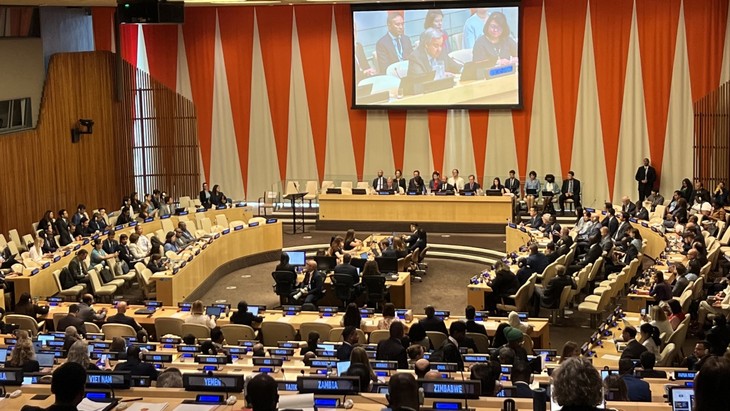(VOVWORLD)-The UN Intergovernmental Conference on Monday adopted a historic agreement for conservation and sustainable use of biodiversity of areas beyond national jurisdiction, known as High Seas Treaty.
 UN Secretary-General Antonio Guterres speaks at the Intergovernmental Conference. (Photo: Vietnamese Delegation to the UN) UN Secretary-General Antonio Guterres speaks at the Intergovernmental Conference. (Photo: Vietnamese Delegation to the UN) |
This is the third document built on the legacy of the UN Convention on the Law of the Sea 1982 (UNCLOS).
UN Secretary-General Antonio Guterres commended the adoption of the agreement as a demonstration of the strength of multilateralism, saying this groundbreaking agreement significantly strengthens the legal framework for the conservation and sustainable use of marine biodiversity in over two-thirds of the ocean.
Addressing the conference, Ambassador Dang Hoang Giang, Permanent Representative of Vietnam to the UN, affirmed that the success reflects the conference’s strong commitment and determination to achieve an instrument for conserving and sustainably using marine biodiversity of areas beyond national jurisdiction.
He said the treaty will further consolidate the 1982 UNSCLOS – the “constitution of the oceans” and a comprehensive legal framework for all sea-related activities, promote multilateralism, be a new landmark in the development of international law, contribute to the implementation of the UN Decade of Ocean Science for Sustainable Development, and help reach Sustainable Development Goal 14 on conservation and sustainable use of the oceans, seas, and marine resources.
The text of the High Seas Treaty was finally agreed in March, after 15 years of discussions and four years of formal negotiations. After being adopted by the United Nations, the treaty needs to be ratified by at least 60 UN member states to come into force.
Currently, almost all protected marine areas lie within individual countries' national territorial waters. The treaty would allow protections to be extended outside of exclusive economic zones (EEZ), which extend to a maximum of 200 nautical miles (370km) from coastlines. More than 60% of the ocean falls outside EEZs. The treaty would also require environmental impact studies for activities like deep-sea mining.
The treaty is important for global efforts to effectively conserve and manage at least 30% of the world’s terrestrial and inland water areas, and of marine and coastal areas by 2030, as agreed in the Kunming-Montreal Global Biodiversity Framework. It also establishes principles for sharing the benefits of "marine genetic resources" (MGR) collected through scientific research in international waters.
The 1982 UNCLOS stipulates the freedom of navigation and fishing on the high seas beyond exclusive economic zones of states, and that seabed resources on the continental shelf of a state are the common heritage of mankind. It also outlines a mechanism for licensing and distributing benefits from seabed mining on the high seas, but has yet to have a similar mechanism for marine genetic resources.
The High Sea Treaty, comprising 17 chapters with 76 articles and two appendices, develops the UNCLOS on this aspect. It is the third treaty to enforce the 1982 UNCLOS, following the UN Fish Stocks Agreement and the Agreement on Part XI of the UNCLOS.